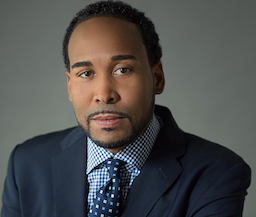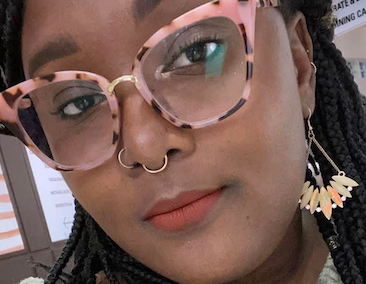One of our core priorities at the Leonard Litz LGBTQ+ Foundation is Racial Justice. We are proud to support programs and services that specifically address the inequalities faced by LGBTQ+ people of color. So supporting this new fellowship from the Washngton Blade Foundation was a natural fit.
The LGBTQ+ community is not a monolith, but rather a cosmic rainbow of intersecting identities. This fellowship helps to explore and spread awareness of this diversity by supporting journalism that focuses on stories at the intersection of LGBTQ+ identities and race. Our struggles are impossible to separate—quite literally for many people. Let’s not forget, people of color were the ones leading the fight at Stonewall. We cannot build a whole future if we only tell half our history.
The Blade has already welcomed its inaugural fellow, Brandie Bland, whose first story, copied below, examines the unique challenges faced by communities of color when it comes to coming out of the closet.
“The visibility of queer sexuality in Black culture can be traced back to the Harlem Renaissance, where literature and music were full of stories about lived queer experiences,” writes Brandie. “And non-binary identities have always been visible and integrated in some communities of color like in North American Indigenous cultures and Pacific Island cultures.”
Read the full story here and below. Congratulations to Brandie! The Leonard Litz LGBTQ+ Foundation is proud to partner with the Washington Blade in this important intersectional work.
Nat’l Coming Out Day presents unique challenges for communities of color
By Brandie Bland
 On the 34th anniversary of National Coming Out Day, LGBTQ people across the country honor the community and its fight for equality. But not everyone sees coming out as a celebration.
On the 34th anniversary of National Coming Out Day, LGBTQ people across the country honor the community and its fight for equality. But not everyone sees coming out as a celebration.
“Coming out is not always the best option for persons of color who already — because of our pigment on top of our identity — face discrimination, hatred and violence,” said Kimberley Bush, executive director and director of Arts and Cultural Programs at the DC Center for the LGBT Community.
The first National Coming Out Day was in 1988. Psychologist Robert Eichberg and gay rights activist Jean O’Leary, both of whom were openly queer and white, created the holiday.
In the U.S., being queer — and what that might look like — often centers whiteness. For many, the term “coming out” continues to center whiteness as the norm for LGBTQ identities.
David Johns, executive director of the National Black Justice Coalition said, “usually the narrative and the images revolve around white folks that sit down with their families and have maybe an uncomfortable conversation, but at some point they celebrate them. Those folks move to gayborhoods like Hollywood, Calif., or Chelsea, N.Y., or Boystown, Chicago. And then they get to join associations around their LGBTQ+ identities that also give them access to forms of capital and privilege that most Black folks don’t get to benefit from.”
The cultural and historical myopia inherent in the term “coming out” can minimize the complicated relationship between pride, visibility, and safety for LGBTQ people within communities of color.
“It is often challenging to be heard, seen, and just simply listened to as a LGBTQ+ person, but when you add on being a person of color, that challenge becomes much more unique and saturated. We are inherently judged, not given credibility to our own life stories and further pushed into the margins and often cannot take or retain the power in the who, when, and how we disclose our identity,” Bush said.
When talking about coming out, Johns, who identifies as same gender loving (SGL), prefers the term “inviting in.”
“The process of inviting in is a term that we use to sort of shift power and highlight the problematic nature of coming out, while also acknowledging and sometimes celebrating,” Johns said.
“Inviting in” signifies that, “no one is entitled to information about the lived experiences of other people that are not voluntarily offered up.”
And “inviting in” reallocates the individual responsibility of “coming out” and challenges the heteronormative expectation that LGBTQ or SGL people should be required to “out” themselves.
The idea of “inviting in” instead of “coming out” for communities of color also intersects with very real safety concerns for many in the community, given the current political climate, the widespread escalation of anti-LGBTQ threats online and attacks on members of the community and providers of trans-affirming healthcare across the country.
“The fact that our lives are dynamic and we face moments, sometimes daily, where we’re forced to think about inviting people in and often have to consider safety, especially now in this current political environment, is often missed,” Johns said.
For people of color living at the intersection of multiple marginalized identities, “coming out” can be even more dangerous because of heightened safety issues specific to communities of color.
“Black and brown humans have always had to fight for our freedoms,” Bush said. “Coming out can be a pressured, intense, repressive and oppressive journey that may not allow a person to feel the freedom to choose inviting in versus coming out. In addition, persons of color also exponentially experience various levels of trauma. Coming out can be an extra layer of repetitive trauma and abuse.”
In LGBTQ communities of color, interpersonal and religious violence and parental or familial responses are some of the traumas community members can face.
A Williams Institute study about parental acceptance of LGBTQ identities across different age groups found that parents gave invalidating responses to their child’s sexual identity across all age groups, and parents of children in younger age groups referred to coming out as “just a phase” or something the child was “too young to know about.”
Religion is often used to invalidate marginalized sexual and gender identities in communities of color.
Dr. Sydney Lewis, a lecturer in the Harriet Tubman Department of Women, Gender, and Sexuality Studies at the University of Maryland, College Park, attributes this negative religious response to Christianity.
“Many Christian churches have a history of being homophobic and transphobic,” Lewis said. “And I think that our reliance on Black Christianity for our community, our safety and our growth and development, has been detrimental to LGBTQ folks of color, specifically Black folks.”
Religious homophobia and transphobia complicate the coming out narrative for many queer people. Elle Moxley, a Black trans woman and founder and executive director of the Marsha P. Johnson Institute, has experienced the harms of religious homophobia and transphobia firsthand.
“I didn’t necessarily, as a Black person, feel comfortable coming out or aligning with any rhetoric around that because a lot of times people are forced out,” Moxley said. “In my experience, growing up as a child in the COGIC (Church of God in Christ) religion, there wasn’t an invitation to come out. I was forced out at 12 years old.”
While queer people have always existed, there is an intentional erasure of gay, trans, and non-binary people within Christianity that stems from colonialism.
The visibility of queer sexuality in Black culture can be traced back to the Harlem Renaissance, where literature and music were full of stories about lived queer experiences. And non-binary identities have always been visible and integrated in some communities of color like in North American Indigenous cultures and Pacific Island cultures. Terms like “fa’afafine” in Samoa and “māhū” in Hawai’i are used to signify that someone identifies as non-binary (or “third gender”).
In LGBTQ communities today, the idea that “coming out” means being more free to openly be yourself in public often elides the very real danger of visibility in trans lives of color.
“There’s this idea that visibility somehow equals greater freedom, but for some people, visibility equals greater danger,” Lewis said.
The Human Rights Campaign reports that 31 trans people have been killed so far this year, while a Williams Institute study found that transgender people are four times more likely than cisgender people to be victims of violent crime.
On a day like National Coming Out Day, which is thought to not only symbolize pride but also inclusion, people like Elle Moxley are asking not for inclusion, but equity.
“I always say that inclusion is something that happened after the fact. I don’t subscribe to that,” Moxley said. “But what I do subscribe to is that reparations are an essential part to how equity in society happens.”
People like David Johns are also calling attention to how complicated a celebration like National Coming Out Day can be for LGBTQ communities of color.
“For the Black trans woman with a disability in Jackson, Miss., or my parents’ state of Texas, given the position that those governors have them in, it probably is not safe for them to come out even on a day we’re raising awareness as a part of a goal,” Johns said.

